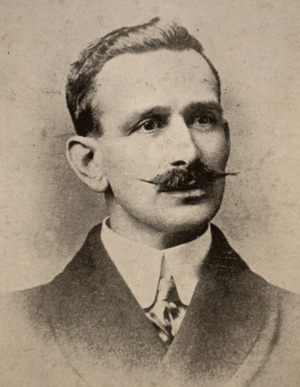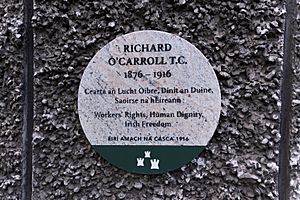Richard O'Carroll facts for kids
Quick facts for kids
Richard O'Carroll
|
|
|---|---|
 |
|
| Dublin City Councilor | |
| In office 1907–1916 |
|
| Constituency | Mansion House Ward |
| Personal details | |
| Born | 29 February 1876 Dublin, Ireland |
| Died | 5 May 1916 (aged 40) Portobello Military Barracks, Dublin, Ireland |
| Resting place | Glasnevin Cemetery, Dublin, Ireland |
| Political party | Sinn Féin, Labour Party |
| Military service | |
| Allegiance | Irish Republican Brotherhood Irish Volunteers |
| Rank | Lieutenant |
| Commands | 2nd Battalion of the Irish Volunteers |
| Battles/wars | Dublin Lockout Easter Rising |
Richard O'Carroll (born February 29, 1876 – died May 5, 1916) was an important Irish leader. He was a trade union leader, a military officer, and a politician. He also helped start the Irish Labour Party. Richard O'Carroll was one of the first people to speak out against using children for work, especially in building. Because of his efforts, the construction industry took a stand against child labor for the first time.
Contents
Richard O'Carroll's Work
Richard O'Carroll was a bricklayer by trade. From 1906 until he died in 1916, he was the main leader, called the General Secretary, of a group for bricklayers and stonelayers. This group was called the Ancient Guild of Incorporated Brick and Stonelayers Trade Union. A trade union is a group of workers who join together to protect their rights and improve their working conditions.
Richard O'Carroll had been very active in the Union for a long time. As General Secretary, he helped the Union grow and get members from all over Ireland, not just Dublin. By the time he passed away, the Union had many local groups and members across the country.
In 1907, Richard O'Carroll was elected to the Dublin City Council. This meant he was a politician who helped run the city. His job was tricky because he was both a union leader and a politician. This meant he had to represent both the workers in his industry and all the people of Dublin at the same time.
In 1912, he helped create the "Dublin Labour Party." This was the political side of the Irish Trades Union Congress, and it later became the Labour Party we know today. Before this, he had been a member of another political group called Sinn Féin.
Fighting Child Labor
In 1911, Richard O'Carroll also became a Poor Law Guardian. This meant he helped look after people who were very poor. He was strongly against using children for work in building and other jobs. He believed it was wrong to take advantage of children.
He suggested that Dublin City Council should not give contracts to companies that used child labor. Even though his idea was not accepted at first, he openly spoke out against the decision. Because of his strong leadership, his trade union, the Ancient Guild of Incorporated Brick and Stonelayers, publicly said they were against using children in the building trade. This was a very important step, as many children worked in construction back in 1911.
Supporting Workers' Rights
In 1912, Richard O'Carroll took over from James Larkin as the Dublin Labour Party's representative on Dublin City Council. He continued in this role during a very difficult time in 1913, known as the Dublin lock-out. This was a big strike where many workers were locked out of their jobs because they wanted to join unions.
Richard O'Carroll was part of a group that helped end the lock-out. He also publicly supported the workers who were not allowed to join unions. A week after a sad event called Bloody Sunday in 1913, where he was hurt by police, he spoke to a large crowd. He stood with other leaders like James Larkin and asked people to vote for Labour Party representatives. He believed this would help improve the civil rights of workers.
Richard O'Carroll was elected to Dublin City Council again in 1915, still representing the Dublin Labour Party.
The 1916 Easter Rising
Richard O'Carroll was a member of two important Irish groups that wanted Ireland to be free: the Irish Republican Brotherhood and the Irish Volunteers.
He took part in the Easter Rising in 1916. This was a rebellion against British rule in Ireland. He fought in the Camden Street area of Dublin as a lieutenant, which is a military rank. He was part of the 2nd Battalion, led by Thomas MacDonagh.
Richard O'Carroll's Death
Richard O'Carroll was the only elected politician who was killed during the Easter Rising.
On April 26, 1916, a British officer named Captain John Bowen Colthurst led a search for rebels in Dublin. He found Lieutenant Richard O'Carroll in a room above a shop. Even though Richard O'Carroll gave up right away, Captain Colthurst ordered him to be shot. Richard O'Carroll was made to kneel on the street and was shot in front of many people.
Richard O'Carroll did not die immediately. He was taken to a hospital where he died nine days later.
Captain Colthurst later claimed that Richard O'Carroll was trying to escape when he was shot. However, other soldiers knew this was not true. Captain Colthurst even tried to get a sergeant to lie about what happened. This shows that Colthurst knew what he did was wrong and was trying to cover it up.
After Richard O'Carroll's death, the military tried to hide what happened. Even though Captain Colthurst was later found guilty but insane for other killings, Richard O'Carroll's shooting was not discussed much during the trial. This made it harder for people to know the full truth about his death.
Richard O'Carroll's Legacy
Richard O'Carroll was buried in Glasnevin Cemetery, where many other Irish leaders are laid to rest. In 1935, a new memorial was put up to remember his life and all he did for Ireland.
Also, a place called O'Carroll Villas on Cuffe Street in Dublin city centre was named after him. In 2016, a special plaque was put up there by the Lord Mayor of Dublin to honor him.
Richard O'Carroll Empowerment Bursary
The Labour Party decided to remember Richard O'Carroll by helping young people continue their education. They created a special award called the Richard O'Carroll Empowerment Bursary. This award gives €2,000 each year to help students. It started in 2016 and continues to help young people today.


